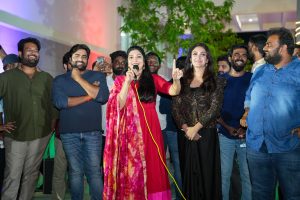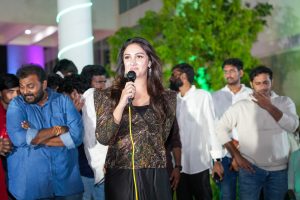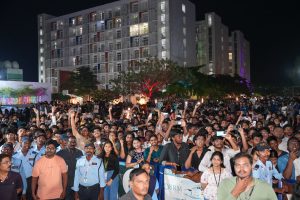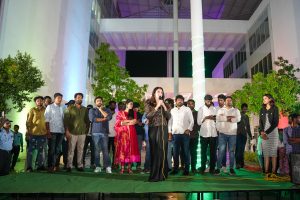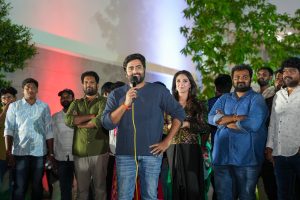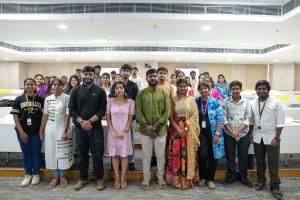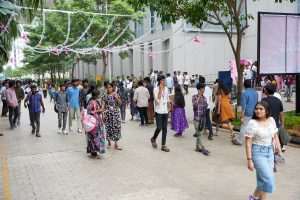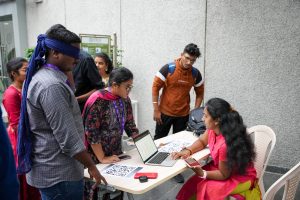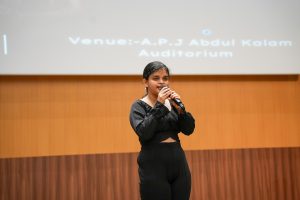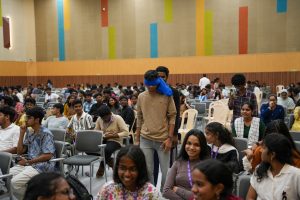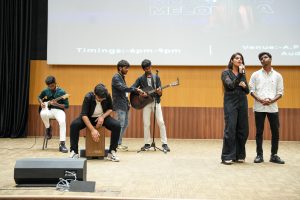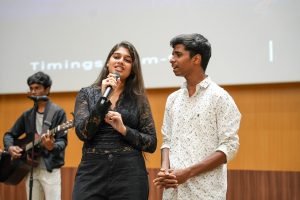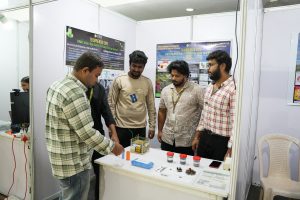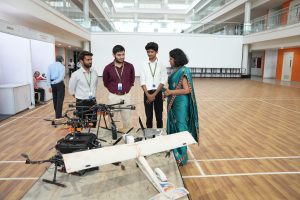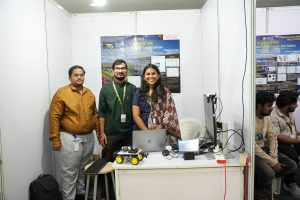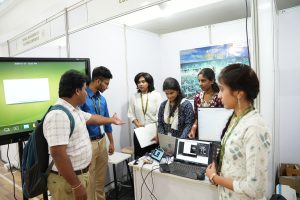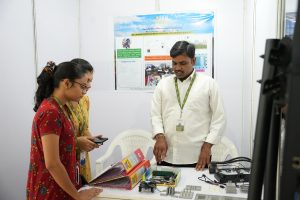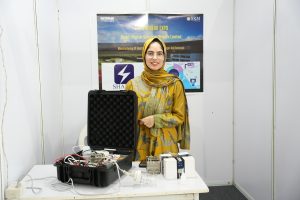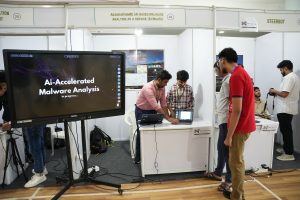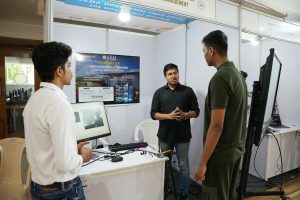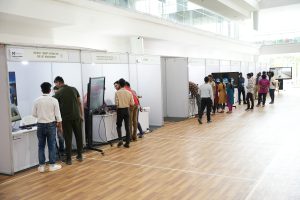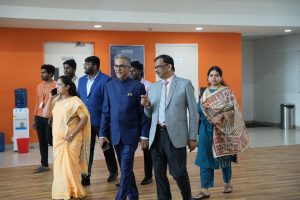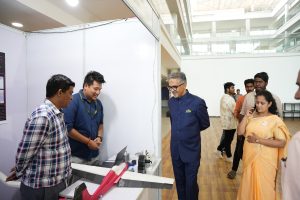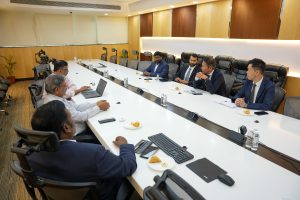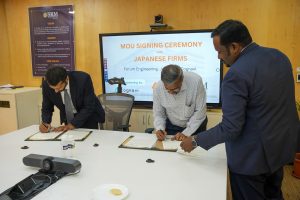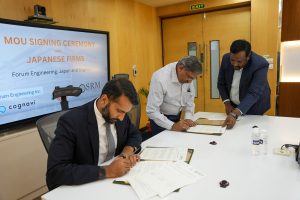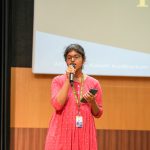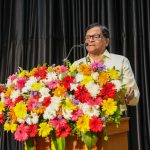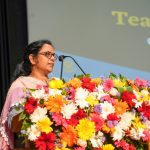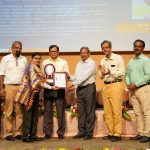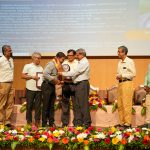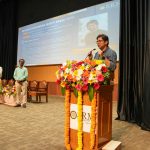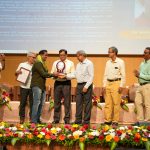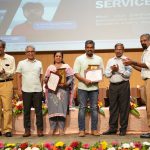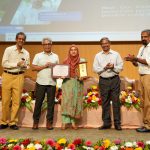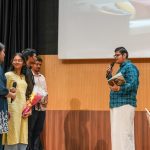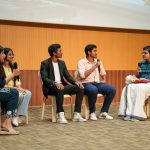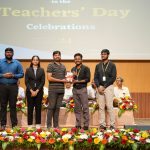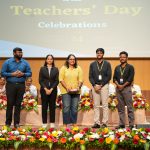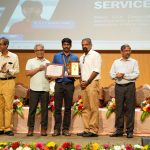New Theories on Dark Matter: Dr Basabendu Proposes New Insights in Q1 Journal
 In a significant advancement in the field of astrophysics, Dr Basabendu Barman, Assistant Professor in the Department of Physics, has published a groundbreaking paper titled “Dark matter-electron scattering and freeze-in scenarios in the light of \textit{Z’} mediation” in the prestigious Q1 journal, Physical Review D, known for its impact factor of 5.0 within the Nature Index.
In a significant advancement in the field of astrophysics, Dr Basabendu Barman, Assistant Professor in the Department of Physics, has published a groundbreaking paper titled “Dark matter-electron scattering and freeze-in scenarios in the light of \textit{Z’} mediation” in the prestigious Q1 journal, Physical Review D, known for its impact factor of 5.0 within the Nature Index.
Dr Barman’s research delves into the enigmatic realm of dark matter, proposing a novel mechanism through which dark matter might interact with the visible universe via a hypothesised fifth force. This interaction could provide vital insights into the nature of dark matter and its elusive characteristics. The study suggests that if this interaction is confirmed, experiments exploring the existence of a fifth force could concurrently unravel the mysteries surrounding dark matter, leading to a deeper understanding of the universe.
This publication not only highlights the potential for new discoveries in particle physics but also positions SRM University-AP at the forefront of cutting-edge research in dark matter studies. Dr. Barman’s findings could pave the way for further exploration and experimental validation, ultimately contributing to the ongoing quest to decode one of the universe’s greatest mysteries.
Abstract:
We investigate dark matter (DM-)electron scattering in a minimal U〖(1)〗_X extension of the Standard Model (SM), where the DM can appear as a Majorana fermion, a complex singlet scalar, or a Dirac fermion. To study bounds on the new gauge coupling and new gauge boson mass, from DM-electron scattering, we consider several direct search experiments like CDMS, DAMIC, SENSEI, PandaX-II, DarkSide-50, and XENON1T-S2 for different U〖(1)〗_X charges. In this setup, we consider DM production via freeze-in in both radiation-dominated and modified cosmological backgrounds to project sensitivities onto coupling vs mass plane satisfying observed relic abundance. DM-electron scattering could provide comparable, or even stronger, bounds compared to those obtained from the electron/muon (g-2), low-energy scattering, and intensity frontier experiments within mass range of 0.01-0.1 GeV. Constrains from freeze-in could provide stronger sensitivities for new gauge boson masses above about 1 GeV ; however, these limits are comparable to those obtained from LHCb and LEP experiments for mass between 10-150 GeV. In the future, electron-muon scattering (MUonE), proton (FASER and DUNE), and electron/positron (ILC) beam-dump experiments could probe these parameters.
From Layperson’s perspective:
We know there are four fundamental forces in nature: strong, weak, electromagnetic, and gravitational. But what if there’s a hidden, fifth force we haven’t discovered yet? The Standard Model of particle physics, which organizes all known particles, doesn’t include this fifth force (and doesn’t include gravity either, unfortunately). So, how can we theoretically create a particle physics model for this possible fifth force? That’s what we explore in this paper. Interestingly, there are already experiments (for example, the Large Hadron Collider or LHC at CERN, Geneva) searching for signs of fifth forces. If this force exists, our model could be tested by these experiments. But there’s more! We also wanted to tackle a big mystery in cosmology: dark matter. Dark matter makes up about 24% of the universe, but we’ve never directly detected it because it doesn’t reflect light—it’s “dark.” However, there are smart ways to try to find it. In this paper, we propose how the same dark matter might interact with the visible universe through this fifth force and thereby leave their footprints. If true, therefore, the experiments looking for the fifth force could also give us clues about the nature of dark matter.
Title:
Dark matter-electron scattering and freeze-in scenarios in the light of Z’ mediation.
In BibTeX (citation) format:
@article{PhysRevD.110.055029,
title = {Dark matter-electron scattering and freeze-in scenarios in the light of ${Z}^{\ensuremath{‘}}$ mediation},
author = {Barman, Basabendu and Das, Arindam and Mandal, Sanjoy},
journal = {Phys. Rev. D},
volume = {110},
issue = {5},
pages = {055029},
numpages = {20},
year = {2024},
month = {Sep},
publisher = {American Physical Society},
doi = {10.1103/PhysRevD.110.055029},
url = {https://link.aps.org/doi/10.1103/PhysRevD.110.055029}
}
Practical Implementations & Social Impact:
The primary goal of this study is to explore what lies beyond the known, visible universe. This curiosity has driven humanity for centuries—to build rockets and explore outer space and to smash particles in colliders, searching for the mysteries hidden within the atom. The desire to uncover the unknown, to shed light on the darkness, is a fundamental part of what it means to be human. In this sense, the work contributes to the realm of pure intellectual pursuit. Science speaks the language of data, and data is born from experiments. The validation of any well-constructed theory ultimately depends on experimental evidence. For this reason, it is essential for society to cultivate a culture that values fundamental scientific discussion and increases funding for basic research.
Collaborations:
This work was done in collaboration with Prof. Arindam Das from the Department of Physics, Hokkaido University, Sapporo, Japan, and Dr. Sanjoy Mandal from the Korea Institute for Advanced Study (KIAS), Seoul, Korea.
Future plans:
- A closer look into early universe dynamics by performing more involved simulations.
- Connection between particle physics models and early Universe cosmology.
- Complementary searches from different experiments in unravelling new physics beyond the Standard Model.
- Searching new physics at energy and intensity frontier.
- Published in Departmental News, News, Physics News, Research News
ALOHA 2024: SRM University AP Freshers’ Extravaganza
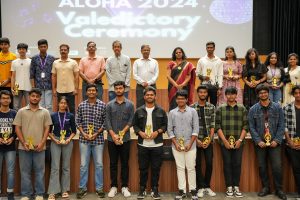 SRM University-AP celebrated Aloha 2024, a welcome to the freshers on this erudite journey. The freshers Party 2024 was an exhilarating two-day celebration filled with entertainment, talent, and camaraderie. The event welcomed freshers with a wide range of activities, competitions, celebrity appearances, and delicious food, ensuring a grand introduction to university life.
SRM University-AP celebrated Aloha 2024, a welcome to the freshers on this erudite journey. The freshers Party 2024 was an exhilarating two-day celebration filled with entertainment, talent, and camaraderie. The event welcomed freshers with a wide range of activities, competitions, celebrity appearances, and delicious food, ensuring a grand introduction to university life.
The festival began with an Inauguration Ceremony, during which dignitaries and guests lit the ceremonial lamp, symbolising new beginnings. Their words of encouragement and advice set the tone for the exciting events to follow. The festival came alive with a variety of Club Competitions, where students showcased their talents in dance, theatre, music, and other creative arts. These competitions not only brought out the freshers’ hidden talents but also fostered a sense of teamwork and fun.
The highlight of the evening was the Neon Arcade, a unique gaming zone set up with vibrant neon lights that gave a nightclub-like atmosphere. Freshers enjoyed arcade games, including bowling, under glowing lights, making it an unforgettable experience. This creative setup became one of the festival’s most talked-about features.
Meanwhile, food stalls lined the venue, offering a wide range of mouth-watering options. From street food to global cuisines, these stalls kept everyone refreshed and energised throughout the day.
Simultaneously, esports enthusiasts engaged in Esports Competitions featuring popular games like FIFA, Valorant, Free Fire, and BGMI. The fierce yet friendly competition made this segment a crowd favourite, drawing both players and fans to experience the excitement.
As with Day 1, the food stalls continued to offer a delightful culinary experience, ensuring that students had plenty of delicious options to enjoy between activities.
In the evening, the excitement reached its peak with the arrival of Nara Rohit, a famous Telugu actor, who visited the campus along with his co-stars to promote his upcoming film. The audience was thrilled as Nara Rohit interacted with fans, shared insights about his movie, and posed for photos. His presence added a touch of glamour to the festival, making Day 2 even more special.
- Published in News, student affairs news
Techpreneur Expo-2024: A Grand Showcase of Innovation and Technology
 In a significant step forward for innovation and entrepreneurship, the Directorate of Entrepreneurship and Innovation recently organised the highly anticipated Techpreneur Expo-2024. The event, held at SRM University-AP, attracted a host of distinguished guests, including Dr Krish Gopalakrishnan, Co-Founder of Infosys; Mr Rohit Kapoor, CEO of Swiggy; Pro-Chancellor of SRM University-AP, Dr P Sathyanarayanan; Vice Chancellor Prof. Manoj Arora; and Registrar Dr R Premkumar, who lent their support and expertise to this integral gathering.
In a significant step forward for innovation and entrepreneurship, the Directorate of Entrepreneurship and Innovation recently organised the highly anticipated Techpreneur Expo-2024. The event, held at SRM University-AP, attracted a host of distinguished guests, including Dr Krish Gopalakrishnan, Co-Founder of Infosys; Mr Rohit Kapoor, CEO of Swiggy; Pro-Chancellor of SRM University-AP, Dr P Sathyanarayanan; Vice Chancellor Prof. Manoj Arora; and Registrar Dr R Premkumar, who lent their support and expertise to this integral gathering.
The Techpreneur Expo served as a vibrant technical showcase featuring 25 stalls presented by the Department of Next Tech Lab, the Directorate of Entrepreneurship and Innovation, and the Department of Research. Attendees were treated to an impressive array of cutting-edge technologies and projects, ranging from Additive Manufacturing and Bio-Printing to advancements in Robotics and Piezoceramics. Noteworthy projects included Unmanned Aerial Vehicles, IoT applications in Drone Technology, and pioneering RF Frontend Designs for 6G Applications. Environmental sustainability was emphasised through displays on Flexible Solid-State Electrolytes for eco-friendly lithium-ion batteries and the Responsible Management of Electronic Waste, along with initiatives for the Reclamation of Critical Metals aimed at fostering Sustainable Development.
In addition to these advanced technologies, the expo presented innovative projects such as Rechargeable Batteries, Smart Indoor Localization, and Edge AI. Guests and participants had the opportunity to explore the Thermal Management of Electronic Components, Hydrogen Fuel Cells, and Waste Valorization projects that advocate for sustainability. Cutting-edge companies, including SYNC-HAB, SecEn Semiconductors & Test Solutions, and Shakti Photon Solutions Private Limited, showcased their contributions to technology solutions. Moreover, unique offerings like Smart Automation and Self-Optimised Clean Energy Systems, No Wait (a smart solution for lift management), and AI-driven initiatives like ResuMatch for resume mock interviews and AdamantiumRE for malware analysis highlighted the inventive spirit of the event.
Throughout the expo, the esteemed guests visited each stall, commending the quality of the displays and the depth of innovation demonstrated by the students. The event proved to be a resounding success, providing invaluable insights and learning opportunities for students while fostering an atmosphere of collaboration and entrepreneurial spirit within the tech community.
The Techpreneur Expo-2024 not only spotlighted the remarkable talents of budding entrepreneurs and innovators but also set the stage for future advancements in technology, signalling a bright horizon for entrepreneurship and innovation in the region.
- Published in CR&CS Webinars, Departmental News, IDEA NEWS, Innovation, News
SRM AP Signs MOU with Forum Engineering Inc. and Cognavi India Private Limited
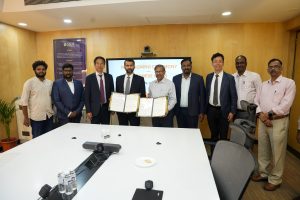 In a landmark move towards enhancing global educational opportunities, SRM University-AP has entered into a Memorandum of Understanding (MOU) with Japan’s Forum Engineering Inc. and Cognavi India Private Limited. The agreement aims to foster collaboration in providing students with career opportunities in Japan’s thriving engineering sector.
In a landmark move towards enhancing global educational opportunities, SRM University-AP has entered into a Memorandum of Understanding (MOU) with Japan’s Forum Engineering Inc. and Cognavi India Private Limited. The agreement aims to foster collaboration in providing students with career opportunities in Japan’s thriving engineering sector.
The signing ceremony, which took place at the SRM University-AP campus, brought together key representatives from all three parties. The MOU outlines a comprehensive operational framework, detailing the roles and expectations of each participant, and sets a clear roadmap for successful partnership.
As per the agreement, SRM University-AP will be responsible for identifying and providing the names and qualifications of students eligible for employment opportunities in Japan. This initiative marks a significant step in promoting international career pathways for students, particularly in engineering fields. Cognavi India will act as an intermediary, facilitating communication between SRM University-AP and Forum Engineering Inc., which will ultimately be responsible for hiring and selecting candidates for positions within its organisation.
“The collaboration with Forum Engineering Inc. and Cognavi India reflects our commitment to expanding our educational impact and providing our students with global career opportunities,” said Dr MS Vivekanandan, Director of Corporate Relations and Career Services, SRM University-AP. “We are excited about the potential of this partnership to transform the lives of our students.”
Forum Engineering Inc., based in Tokyo, is a well-established entity in the engineering sector, known for its innovative solutions and skilled workforce. The company expressed enthusiasm about the collaboration, emphasising its dedication to attracting talented graduates from SRM University-AP.
Through this partnership, we aim to bridge the gap between education and industry, creating pathways for talented individuals from India to thrive in Japan’s dynamic work environment.
Cognavi India, playing a crucial role in this partnership, will ensure that the processes of recruitment and selection are streamlined and effective, guaranteeing that both students and the partnering companies benefit from this initiative.
The MOU signifies a progressive step forward in enhancing educational collaborations between India and Japan, as well as reinforcing SRM University-AP’s position as a leading educational institution committed to student success on a global scale.
This agreement not only paves the way for students to gain valuable international experience but also fosters cultural exchanges that can lead to broader professional networks and opportunities in the future.

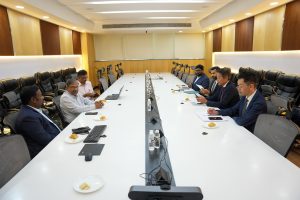
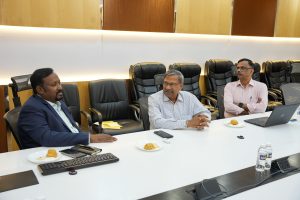
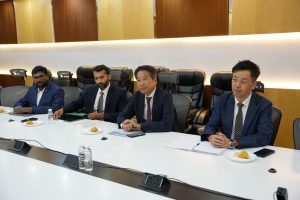

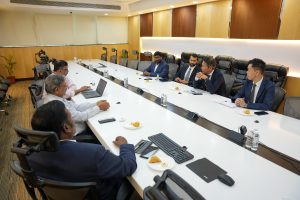
- Published in CR&CS NEWS, Departmental News, News
SRM University-AP Honoured Faculty for their Exemplary Excellence in the Field of Education
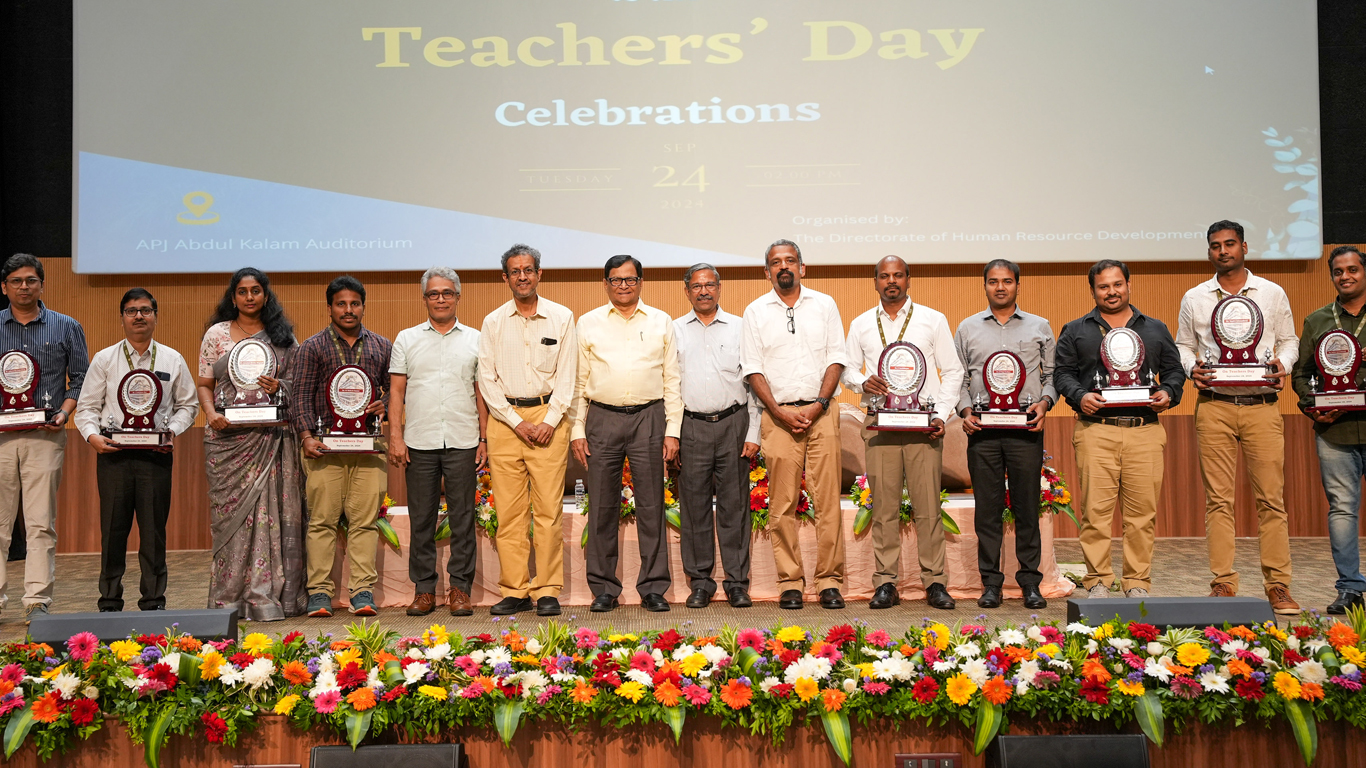 SRM University-AP, renowned for its commitment to academic excellence and holistic development, celebrated Teachers’ Day jointly organised by the Directorate of Human Resources & Development and the Directorate of Student Affairs with a heartful tribute to its dedicated faculty members. The event was a testament to the profound impact that teachers have on their student’s lives, shaping not only their academic journeys but also their personal and professional growth.
SRM University-AP, renowned for its commitment to academic excellence and holistic development, celebrated Teachers’ Day jointly organised by the Directorate of Human Resources & Development and the Directorate of Student Affairs with a heartful tribute to its dedicated faculty members. The event was a testament to the profound impact that teachers have on their student’s lives, shaping not only their academic journeys but also their personal and professional growth.
The event was celebrated in the presence of Prof. V S Rao, Advisor; Dr R Premkumar, Registrar, SRM University-AP; Deans; directors; faculty members; and students. It was a collaborative effort by students and staff, who joined hands to pay respectful tribute to the faculty’s exemplary service. The Chief Guest for the event, Prof Devang V Khakhar, Former Director of IIT Bombay, graced the occasion virtually.
During the occasion, Prof V S Rao, Advisor to SRM University-AP, added his words of appreciation, stating, “Teachers are the architects of tomorrow’s world. Their dedication, passion, and commitment inspire and empower the students to reach their full potential. Our faculty members are transitioning from traditional teaching roles to becoming mentors and facilitators.”
In his speech, Chief Guest Prof. Devang V Khakhar underscored the pivotal role of faculty in a university’s success. He stated, “The strength of an academic institution lies in its teachers. They shape the future by enhancing students’ learning capabilities and skills. Indeed, teachers are the true pillars of any academic institution.”
The event also marked the announcement of the Outstanding Faculty Awards, honouring Dr Sunil Chinnadurai, Associate Professor, Department of ECE; Dr Lakshmi Sirisha Maganti, Assistant Professor, Department of Mechanical Engineering; Dr Karthikeyan E, Assistant Professor, Department of ECE; Dr Mahesh Kumar M, Assistant Professor, Department of CSE; Dr Satish Anamalamudi, Associate Professor, Department of CSE; Dr Sabyasachi Chakrabortty, Associate Professor, Department of Chemistry; Dr Rajapandiyan Panneerselvam, Assistant Professor, Department of Chemistry; Dr Vimal Babu – Associate professor, Department of Management; Dr Lakshmana Rao Ayyangari, Associate professor, Department of Commerce for their exceptional contributions to their respective departments. Dr Sutharsan Govindarajan, Assistant Professor in the Department of Biological Sciences, was bestowed with the “Prof. V S Rao Foundation – Prof. HP Tiwari Best Faculty Award“.
The awardees expressed their gratitude to the university and students in their acceptance speeches.
The ceremony also recognised the dedication of faculty members with the Five-Year Services Award. The celebration was moderated by Prof. Sheela Singh, Associate Director of Faculty Affairs, who provided insightful commentary and ensured a smooth flow of events. The celebration concluded with a series of captivating performances by students, showcasing their talents and appreciation for their teachers. The Students Council presented the token of gifts to select adorable teachers. The event was a memorable occasion that highlighted the strong bond between students and faculty at SRM University-AP.
- Published in Departmental News, News, student affairs news
SRM AP’s Hatchlab Research Centre Selected as Implementation Agency for GENESIS Scheme
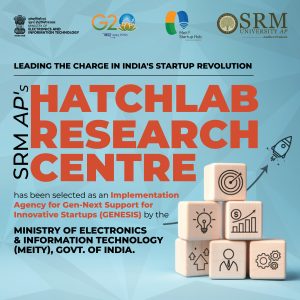 The Directorate of Entrepreneurship and Innovation is thrilled to announce that the Hatchlab Research Centre (HRC), the Technology Business Incubator at SRM University-AP, has been chosen as the Implementation Agency for the “Gen-Next Support for Innovative Startups (GENESIS)” initiative. This decision, made by the Ministry of Electronics & Information Technology (MeitY), Government of India, marks a significant milestone for HRC and highlights its commitment to fostering innovation and entrepreneurship.
The Directorate of Entrepreneurship and Innovation is thrilled to announce that the Hatchlab Research Centre (HRC), the Technology Business Incubator at SRM University-AP, has been chosen as the Implementation Agency for the “Gen-Next Support for Innovative Startups (GENESIS)” initiative. This decision, made by the Ministry of Electronics & Information Technology (MeitY), Government of India, marks a significant milestone for HRC and highlights its commitment to fostering innovation and entrepreneurship.
The GENESIS scheme emerges as a strategic umbrella initiative by MeitY aimed at nurturing and supporting startup ecosystems in Tier II and Tier III cities across India. HRC is among the 50 selected implementation agencies tasked with facilitating this vision, backed by a total budgetary allocation of ₹490 crores. This funding will be instrumental in providing vital resources and infrastructure for startups, ensuring they have the necessary support to thrive in a competitive landscape.
Prof. Sidharth Shankar Tripathy, Director of Entrepreneurship & Innovation of SRM AP, said, ” This announcement is a tribute to the soaring entrepreneurial spirit that is visible among the students, faculty and even the staff of our young entrepreneurial university. What makes this achievement even more special is that it was announced at an appropriate juncture time when SRM University-AP had declared the academic year 2023-24 as the “Year of Entrepreneurship & Innovation.With this new responsibility, we look forward to contributing to the success of startups and innovators across India!”
The HRC’s selection comes at a fortuitous time, as SRM University-AP has declared the 2023-24 academic year to be the “Year of Entrepreneurship & Innovation.” This initiative aims to foster a culture of creativity and entrepreneurial spirit among students, providing them with the tools and support needed to transform their ideas into viable business ventures.
The GENESIS scheme is designed to enhance the startup ecosystem in smaller cities, enabling entrepreneurs outside of metropolitan areas to access essential services, mentorship, and funding opportunities. By selecting HRC as an implementation partner, MeitY acknowledges the centre’s potential to drive impactful change and support innovative startups in the region.
As HRC embarks on this new journey, it promises to create a robust framework that encourages collaboration, knowledge sharing, and the development of sustainable business models among emerging entrepreneurs. The centre will facilitate various programs, workshops, and resources designed to equip startups with the skills, network, and funding requisite for success.
With this prestigious recognition, SRM University-AP’s Hatchlab Research Centre is poised to play a pivotal role in transforming the entrepreneurial landscape, paving the way for a more inclusive and diverse startup ecosystem across the nation.
- Published in Departmental News, IDEA Events, IDEA NEWS, Innovation, News
Dr Rupesh Kumar Secures Major Research Grant for Amazon Forest Canopy Mapping Project
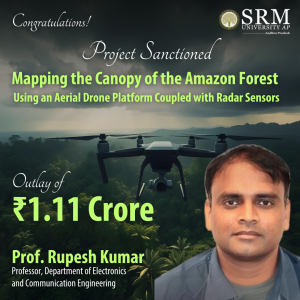 In a groundbreaking development, Dr Rupesh Kumar, a Professor in the Department of Electronics and Communication Engineering, has been awarded a significant project titled “Mapping the Canopy of the Amazon Forest Using an Aerial Drone Platform Coupled with Radar Sensors.” The initiative, funded by the International Peruvian National Research Institute, boasts an impressive outlay of Rs. 1.11 Crores and is set to span over a two-year period.
In a groundbreaking development, Dr Rupesh Kumar, a Professor in the Department of Electronics and Communication Engineering, has been awarded a significant project titled “Mapping the Canopy of the Amazon Forest Using an Aerial Drone Platform Coupled with Radar Sensors.” The initiative, funded by the International Peruvian National Research Institute, boasts an impressive outlay of Rs. 1.11 Crores and is set to span over a two-year period.
The project is spearheaded by Principal Investigator Dr Mark Donny Clemente Arenas, an Associate Professor at the National Technological University of South Lima in Peru. This collaboration aims to enhance the understanding of the Amazon’s intricate canopy structure and promote conservation efforts through innovative technology.
In recognition of this notable achievement, SRM University-AP proudly congratulated Dr Kumar and highlighted the significant impact this project could have on environmental research and sustainability. The university’s support underscores its commitment to fostering research initiatives that address global challenges, encouraging faculty members to pursue innovative solutions through collaboration and the application of cutting-edge technology.
This initiative marks a significant milestone in international research collaboration, leveraging technology to address critical environmental challenges in one of the world’s most vital ecosystems.
A Brief Description of the Project
This project facilitates the mapping of the Amazon forest in Peru. An integrated approach of advanced sensors such as LiDAR, Millimeter-Wave Radar, Camera, etc. and UAV will achieve this.
This will help assess the Amazon forest’s health in real time by leveraging the ML/AI approaches.
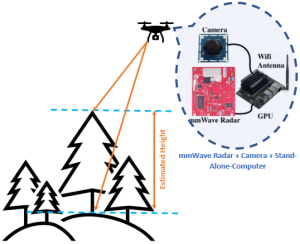
Figure 1: Scheme for height estimation
Explanation of the Research in Layperson’s Terms
The plant/tree generally reflects radio waves and other signals, and this reflection depends on the density of the forest. If a suitable signal processing is applied to the reflected signals, it will provide insight information about the forest profile. Nevertheless, this will help in the quantification of land covered by trees, identifying the location of those trees. Consequently, the tree canopy assessments help in determining the amount and location of impervious cover.
Funding Agency and Amount Sanctioned
National Scientific Research and Advanced Studies Program (PROCIENCIA) of the National Council for Science, Technology and Technological Innovation (CONCYTEC), Peru.
In Spanish: “ Programa Nacional de Investigación Cientifica y Estudios Avanzados (PROCIENCIA), del Consejo Nacional de Ciencia, Tecnología e Innovación
Tecnológica (CONCYTEC), Perú”.
Practical Implementation of the Research or the Social Implications Associated with it
The proposed research work help will help in the assessment of deforestation as well as its impact on climate change and global warming. Not only this, but the research will also contribute to achieving carbon neutrality by 2050!
Collaborations
Universidad Nacional Tecnológica de Lima Sur
Collaborator: Prof. Mark Clement Arenas
Future Research Plans
In future, this work will be extended for infrastructure monitoring. With the boom in real estate, a continuous monitoring system is desired for proper maintenance.
- Published in Departmental News, ECE NEWS, News, Research News
Dr Jaidev Kaushik’s Publishes New Publication on Graphene Incorporated Aerogels
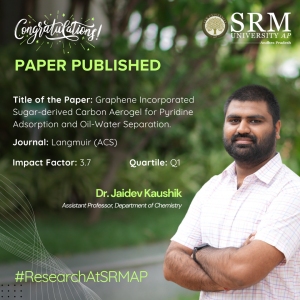 Dr Jaidev Kaushik, an Assistant Professor in the Department of Chemistry, has recently published a pioneering research paper in the prestigious journal Langmuir (ACS). The paper, titled “Graphene Incorporated Sugar-derived Carbon Aerogel for Pyridine Adsorption and Oil-Water Separation,” explores innovative applications of graphene-based materials.
Dr Jaidev Kaushik, an Assistant Professor in the Department of Chemistry, has recently published a pioneering research paper in the prestigious journal Langmuir (ACS). The paper, titled “Graphene Incorporated Sugar-derived Carbon Aerogel for Pyridine Adsorption and Oil-Water Separation,” explores innovative applications of graphene-based materials.
Dr Kaushik’s research focuses on the development of a novel carbon aerogel derived from sugar and incorporated with graphene. This material demonstrates exceptional efficiency in adsorbing pyridine, a harmful organic compound, and effectively separating oil from water. These findings hold significant promise for environmental remediation and industrial applications, offering a sustainable solution to pollution and waste management challenges.
The publication of this paper in Langmuir highlights the cutting-edge research being conducted at SRM University-AP and underscores Dr Kaushik’s contributions to the field of chemistry. His work not only advances scientific understanding but also paves the way for practical applications that can benefit society at large.
Abstract
In this report, we have synthesized three-dimensional and hydrophobic graphene-incorporated carbon aerogel (G-SCA) derived from sugar. G-SCA is being used as a multifunctional sorbent material for removing various advanced water soluble and insoluble pollutants Initially, G-SCA is being explored for the adsorption of nitrophenols, nitroaromatics (3-nitroaniline), insecticide (Phoskill), antibiotic (ciprofloxacin), and pharmaceutical drug precursor (pyridine). Later, same G-SCA is also explored in the absorption of various protic and aprotic organic solvents and oils (including crude oil, waste cooking oil, and waste Mobil oil), with excellent recyclability checked up to 10 cycles. Moreover, oil-water separation experiments are also being done in various industrial wastewater samples and seawater to support the real-life accessibility of present approach. Large-scale applicability of G-SCA is also checked by performing crude oil-seawater separation experiments using a laboratory-scale prototype demonstrating the successful continuous recovery of crude oil.
Explanation of The Research in Layperson’s Terms
This research demonstrates the synthesis of carbon aerogel from edible sugar followed by the incorporation of graphene oxide to make a near superhydrophobic and good water-floating sorbent material. Later, this sorbent material was used to decontaminate wastewater from advanced pollutants such as explosive wastes, expired antibiotics, pharmaceutical waste, insecticides, etc. This report also showed the practical demonstration of crude oil recovery from seawater, thus contributing to the circular economy process.
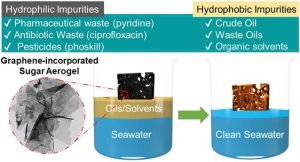
Title of Research Paper in the Citation Format
F. Agrawal, K. Gupta, J. Kaushik, K. M. Tripathi, S. K. Choudhary, S. K. Sonkar, Graphene Incorporated Sugar Derived Carbon Aerogel for Pyridine Adsorption and Oil–Water Separation, Langmuir 2024, 40, 18028–18038.
Practical Implementation or the Social Implications Associated with the Research
This work describes the synthesis of low-cost near superhydrophobic carbon aerogel, displaying its multiple applications in wastewater treatment from water-soluble and water-insoluble pollutants. It is also an alternative and cost-effective approach for recovering valuable oil and organic compounds from water rather than degrading or destroying them so they can be reused.
Collaborations
Dr Sumit Kumar Sonkar (MNIT Jaipur, India)
Future Research Plans
1. The adsorption/photodegradation-assisted quick and efficient removal of next generation advanced pollutants such as microplastic, pesticides, pharmaceutical waste, etc. by hydrophobic carbon aerogel and their doped and functionalised versions.
2. Utilizing waste derived heterogeneous catalysts in organic transformation reactions.
3. Selective sensing of toxic metal ions/biomarkers/biomolecules using fluorescent nanomaterials.
4. Upcycling of carbonates/CO2 via photo/thermal assisted reactions to get C1 and C2 hydrocarbons (green fuel).
- Published in Chemistry-news, Departmental News, News, Research News
Unveiling Innovations: Dr Ghosh Publishes Findings on 300 GHz Communication Links
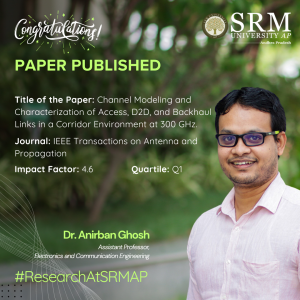 Dr Anirban Ghosh, an esteemed Assistant Professor in the Department of Electronics and Communication Engineering, has recently published a significant research paper titled “Channel Modeling and Characterization of Access, D2D, and Backhaul Links in a Corridor Environment at 300 GHz.” This paper has been featured in the prestigious Q1 Journal, IEEE Transactions on Antenna and Propagation, with an impressive impact factor of 4.6.
Dr Anirban Ghosh, an esteemed Assistant Professor in the Department of Electronics and Communication Engineering, has recently published a significant research paper titled “Channel Modeling and Characterization of Access, D2D, and Backhaul Links in a Corridor Environment at 300 GHz.” This paper has been featured in the prestigious Q1 Journal, IEEE Transactions on Antenna and Propagation, with an impressive impact factor of 4.6.
Dr Ghosh’s research delves into the intricate aspects of channel modelling and characterisation, focusing on access, device-to-device (D2D), and backhaul links within a corridor environment at a high frequency of 300 GHz. This study is poised to make substantial contributions to the field of wireless communication, particularly in enhancing the understanding and development of next-generation communication systems.
The publication in such a renowned journal underscores the quality and impact of Dr. Ghosh’s work, reflecting the cutting-edge research being conducted at SRM University – AP. The university community extends its heartfelt congratulations to Dr. Ghosh for this remarkable achievement and looks forward to his continued contributions to the field of electronics and communication engineering.
Abstract:
This paper presents comprehensive double-directional channel measurements at 300 GHz across various corridor scenarios, including Access, Device-to-Device (D2D), and Backhaul, using an in-house developed channel sounder. The measurements, validated by ray tracing simulations, reveal that while 300 GHz quasi-optical propagation in corridors can be modeled using ray optics, non-trivial propagation phenomena, such as quadruple-bounce reflections, also occur. To accurately model these mechanisms, a quasi-deterministic (QD) channel model combining deterministic and random components is proposed. The QD model results align well with observations, highlighting similar propagation mechanisms for Access and D2D scenarios, while Backhaul scenarios show Line-of-Sight (LoS) impacts from ceiling reflections. These findings are crucial for designing next-generation THz communication systems.
Explanation of Research in Layperson’s Terms
This research contributes to building the next generation of communication networks, which will significantly impact society by improving connectivity, supporting technological advancements, and promoting economic development, and bringing forth several futuristic applications.
Practical Implementation
The results align with the design of high-frequency ultra-high speed, low-latency, reliable communication envisioned for several futuristic applications using beyond 5G and 6G networks.

The measurement scenarios explored in the paper.
Collaborations
Prof. Minseok Kim
Professor, Faculty of Engineering, Course of Electrical and Electronics Engineering
Niigata University, Japan.
e-mail: mskim@eng.niigata-u.ac.jp
Future Research Plans
The efforts would be extended to other communication scenarios for a similar study. Additionally, generating appropriate channel models, coverage design, link budget, etc for the explored and unexplored scenarios would also encompass an interesting study.
- Published in Departmental News, ECE NEWS, News, Research News
Dr Mahesh Kumar Secures Patent for Advanced Data Generation Method
 In a significant achievement for the Department of Computer Science and Engineering, Dr Mahesh Kumar Morampudi, Assistant Professor, along with B.Tech. student Ms. Nunna Lakshmi Manasa, has been granted a patent for their groundbreaking invention titled “System and method for generating synthetic data based on variational autoencoder.” The patent, with Application Number: 202241049545, was officially recognised in the Indian Patent Office.
In a significant achievement for the Department of Computer Science and Engineering, Dr Mahesh Kumar Morampudi, Assistant Professor, along with B.Tech. student Ms. Nunna Lakshmi Manasa, has been granted a patent for their groundbreaking invention titled “System and method for generating synthetic data based on variational autoencoder.” The patent, with Application Number: 202241049545, was officially recognised in the Indian Patent Office.
This innovative system leverages the capabilities of variational autoencoders to generate synthetic data, which has vast applications in various fields, including machine learning, data privacy, and simulation. The ability to create high-quality synthetic datasets can significantly enhance research and development processes, providing researchers and practitioners with valuable tools for analysis and experimentation.
The recognition of this patent not only highlights the innovative spirit within the department but also underscores the collaborative efforts between faculty and students in advancing technology and contributing to the field of computer science.
Abstract of the Research
Diabetic retinopathy (DR) is a diabetes-related eye condition that occurs when high blood sugar levels cause damage to the blood vessels in the retina, the light-sensitive tissue at the back of the eye. Over time, these damaged vessels can leak blood or other fluids, leading to vision impairment.
DR typically progresses through stages, starting with mild non-proliferative retinopathy, where small bulges form in the blood vessels, to proliferative retinopathy, the most severe stage, where new abnormal blood vessels grow on the retina and in the vitreous humor, potentially leading to blindness. Early detection and management are crucial to prevent significant vision loss, often involving regular eye exams, blood sugar control, and treatments like laser therapy or surgery.

Synthetic data generation for DR is an emerging approach to augment limited clinical datasets, enhancing the training of machine learning models for diagnosis and prognosis. The present disclosure envisages a system for generating synthetic data based on a variational autoencoder (VAE). This work explores the use of a VAE combined with deep learning for the detection and classification of DR. VAEs, known for their ability to learn compact and meaningful representations of complex data, are employed to generate latent features from retinal images, effectively capturing the subtle variations and anomalies indicative of DR. These latent features are then fed into a deep learning classifier, which is trained to categorise the severity of DR into various stages, ranging from no DR to proliferative DR.
Research in Layperson’s Terms
Imagine your eye is like a camera, and the retina at the back of your eye is the film that captures the pictures you see. DR is a condition that affects this “film” when someone has diabetes for a long time. High blood sugar levels can damage the tiny blood vessels in the retina, leading to vision problems and, in severe cases, blindness.
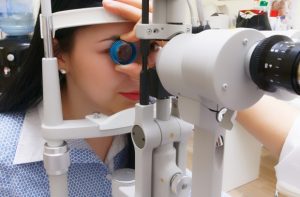
Our research is about creating a computer program that can help doctors detect and classify this eye condition more accurately. We use a special kind of technology called a VAE, which is like a smart artist that learns to understand and recreate detailed images of the retina. This “artist” can pick up on the tiny changes and patterns in the retina that might be missed by the human eye. Once the VAE has learned these details, it passes them on to another program, which is really good at sorting things into categories. This second program, a deep learning classifier, uses the information from the VAE to decide how severe diabetic retinopathy is—whether it’s mild, moderate, or severe.
By combining these two technologies, our system can help doctors detect diabetic retinopathy earlier and more accurately, which is crucial for preventing vision loss in people with diabetes.
Title of the Patent in the Citation Format
Inventor Name(s):
Dr Mahesh Kumar Morampudi
Nunna Lakshmi Manasa
“System and method for generating synthetic data based on variational auto encoder” with Application Number: ” 202241049545.” Date of Patent Grant. 29/07/2024
Practical Implementation:
The practical implementation of our research involves integrating the VAE and deep learning classifier into a software tool that can be used by eye care professionals. Here’s how it might work in a real-world setting:
- Data Collection: Retinal images are collected from patients during routine eye exams. These images are fed into the system, which has been trained using a large dataset of retinal images, including those showing different stages of DR.
- Feature Extraction: The VAE processes these images, learning to capture and condense the important features that indicate the presence and severity of DR. This step is crucial because it allows the system to focus on the subtle details that might signify early stages of the disease.
- Classification: The deep learning classifier then takes these features and classifies the severity of DR. It provides a diagnosis, categorising the condition as no DR, mild, moderate, or severe. The system could also flag cases that need urgent attention, helping prioritise patient care.
- Clinical Decision Support: The results are presented to the healthcare provider through an intuitive interface. This tool could be used in clinics, especially in areas with limited access to specialised eye care, allowing general practitioners or technicians to screen for DR and refer patients for further treatment if needed.
Social Implications:
- Increased Access to Early Detection: By automating the detection of diabetic retinopathy, this technology can be deployed in remote or underserved areas where access to specialists is limited. Early detection is key to preventing vision loss, and this tool can make screening more accessible, especially in communities with high rates of diabetes.
- Reduced Healthcare Costs: Early detection and treatment of diabetic retinopathy can prevent the progression to more severe stages, reducing the need for expensive treatments like surgery or long-term care for blindness. This could lower healthcare costs for both patients and the healthcare system.
- Empowering Healthcare Providers: The tool can support general healthcare providers in making more accurate diagnoses, reducing the burden on specialists and allowing them to focus on more complex cases. This democratizes eye care, making it possible for more people to get the care they need without long delays.
- Improved Patient Outcomes: With more accurate and timely diagnosis, patients can receive treatment sooner, leading to better health outcomes and preserving vision. This can significantly enhance the quality of life for individuals with diabetes, who might otherwise suffer from preventable blindness.
- Ethical Considerations: While technology offers many benefits, it also raises ethical questions about the use of AI in healthcare, such as ensuring that the system is fair, transparent, and does not introduce biases. Continuous monitoring and updates would be necessary to ensure the system remains accurate and equitable.
Future Research Plans
- Improving Model Robustness and Generalization: Enhance the VAE and deep learning classifier’s ability to generalize across diverse populations and imaging conditions.
- Incorporating Multimodal Data: Integrate additional data sources, such as patient medical history, blood sugar levels, and genetic information, to improve diagnostic accuracy.
- Real-Time Implementation and Mobile Integration: Adapt the system for real-time analysis and deploy it on mobile devices.
- Collaboration with Clinical Trials: Validate the AI system’s effectiveness through collaboration with clinical trials.
- Published in CSE NEWS, Departmental News, News, Research News


